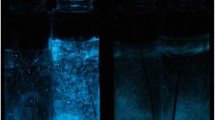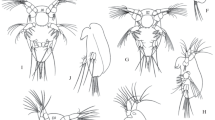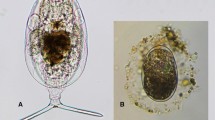Abstract
The light organs of monocentrid and anomalopid fishes consist of bacteria-filled tubular invaginations of the epidermis which are connected to the surrounding seawater by ducts. We used the release of bacteria from the light organs to estimate bacterial rates of growth in the light organs. For one monocentrid fish (4 specimens of Monocentris japonicus collected at Jogashima, Japan in 1980) and for two anomalopid fishes (2 specimens each of Photoblepharon palpebratus collected at Sebu, Phillipines in 1981 and Grand Comore Island in 1975 and Kryptophanaron alfredi collected at Parguera, Puerto Rico in 1982) we measured rates of release of bacteria into the surrounding seawater and the bacterial population sizes in the light organs; from this information we calculated doubling times of bacteria in the light organs. In addition, we determined the luminescence of bacteria after their release into the seawater. For M. japonicus, two specimens released 1.1 to 6×106 and 2×107 bacteria h−1, respectively; the light organs contained about 1.5×108 bacteria. For P. palpebratus, one specimen released 2.2×108 bacteria h−1; a second specimen had light organs containing 5.2×109 bacteria. For K. alfredi, one specimen released 7×107 bacteria h−1 and had light organs containing 5.6×108 bacteria; a second specimen released 3.6×107 bacteria h−1 and had light organs containing 7.3×108 bacteria. Bacterial doubling times in the light organs of these three fishes were variable and ranged from 7.5 to 135 h in M. japonicus and 8 to 23 h in the anomalopids. Bacteria released from M. japonicus into the seawater remained viable, but bacteria from all of the fishes soon ceased to emit light.
Similar content being viewed by others

Literature cited
Colin, P. L., D. W. Arneson and W. F. Smith-Vaniz: Rediscovery and redescription of the Caribbean anomalopid fish Kryptophanaron alfredi Silvester and Fowler (Pisces: Anomalopidae). Bull mar. Sci. 29, 312–319 (1979)
Haneda, Y. and F. I. Tsuji: Light production in the luminous fishes Photoblepharon and Anomalops from the Banda Islands. Science, N.Y. 173, 143–145 (1971)
Hobbie, J. E., R. J. Daley and S. Jasper: Use of Nuclepore filters for counting bacteria by fluorescence microscopy. Appl. envirl Microbiol. 33, 1225–1228 (1977)
Kessel, M.: The ultrastructure of the relationship between the luminous organ of the teleost fish Photoblepharon palpebratus and its symbiotic bacteria. Cytobiol. 15, 145–158 (1977)
McCosker, J. E.: Discovery of Kryptophanaron alfredi (Pisces: Anomalopidae) at San Salvador, Bahamas, with notes on anomalopid light organs. Revta Biol. trop. 30, 97–99 (1982)
Nealson, K. H.: Identification and manipulation of luminous bacteria. Meth. Enzym. 57, 153–166 (1978)
Nealson, K. H.: Alternative strategies of symbiosis of marine luminous fishes harboring light emitting bacteria. Trends biochem. Sci. 4, 105–110 (1979)
Nealson, K. H., M. G. Haygood, B. M. Tebo, M. Roman, E. Miller and J. E. McCosker: Contributions by symbiotically luminous fishes to bioluminescence and luminous bacterial populations in seawater. Microb. Ecol. (In press)
Ruby, E. G. and K. H. Nealson: Symbiotic association of Photobacterium fischeri with the marine luminous fish Monocentris japonica: a model of symbiosis based on bacterial studies. Biol. Bull. mar. Biol. Lab., Woods Hole 151, 574–586 (1976)
Stanier, R. Y., E. A. Adelberg and J. L. Ingraham: The microbial world, 871 pp. Englewood Cliffs, N.J.: Prentice-Hall 1976
Tebo, B. M., D. S. Linthicum and K. H. Nealson: Luminous bacteria and light-emitting fish: ultrastructure of the symbiosis. Biosystems (Amsterdam) 11, 269–280 (1979)
Yasaki, Y.: On the nature of the luminescence of the knight-fish (Monocentris japonicus (Houttuyn)). J. exp. Zool. 50, 495–505 (1928)
Author information
Authors and Affiliations
Additional information
Communicated by N. D. Holland, La Jolla
Rights and permissions
About this article
Cite this article
Haygood, M.G., Tebo, B.M. & Nealson, K.H. Luminous bacteria of a monocentrid fish (Monocentris japonicus) and two anomalopid fishes (Photoblepharon palpebratus and Kryptophanaron alfredi): population sizes and growth within the light organs, and rates of release into the seawater. Marine Biology 78, 249–254 (1984). https://doi.org/10.1007/BF00393010
Accepted:
Issue Date:
DOI: https://doi.org/10.1007/BF00393010



